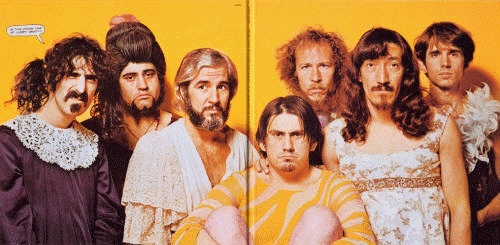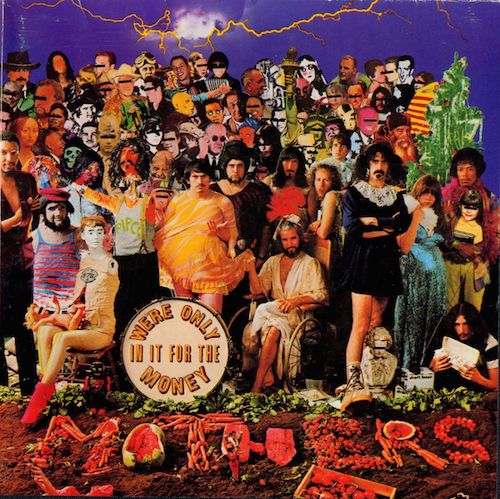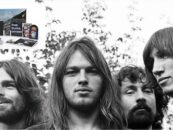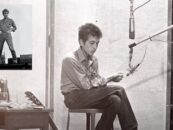
The Mothers of Invention’s We’re Only In It for the Money, with Frank Zappa in pigtails at left (outside front cover)
In the late ’60s, when rock music was exploding in countless, new creative directions, when musicians were testing all of the limits—in the studio, onstage and in life—the Mothers of Invention proudly declared themselves freaks. And their leader, Frank Zappa, was the freakiest freak of all.
He’d first come to the attention of the public in a small way in 1963, when he appeared, as a young man with a greasy pompadour, on The Steve Allen Show—“playing” a bicycle. (Scroll to the bottom to check out the video.)
For rock fans though, it was the Mothers’ debut LP, appropriately titled Freak Out!, that first opened our eyes and ears. Released on Verve Records in June 1966, it was only rock’s second double album (preceded by Dylan’s Blonde on Blonde), but the fact that it was recorded by a band unknown outside of the Los Angeles club circuit made it an instant curiosity—especially when DJs and fans heard what kind of outrageousness these crazy-looking Mothers were up to.
Freak Out! was unlike any other rock album that had come before. Produced by Tom Wilson—whose other clients included Bob Dylan, the Velvet Underground, Simon and Garfunkel and many notable jazz artists—it threw into a crockpot all manner of oddness: avant-garde experimentalism, blistering psychedelic rock (although Zappa eschewed drugs), doo-wop, blues and more, with songs, often satirical, pointing fingers at authoritarianism, hypocrisy and, in “Trouble Every Day,” the very real horror of race riots plaguing the Watts section of Los Angeles. The album ended with a side-long, 12-minute freeform jam called “The Return of the Son of Monster Magnet (Unfinished Ballet in Two Tableaux)” that established the Mothers of Invention as some of the most gifted and boundary-busting musicians in rock.
On album number two, Absolutely Free, released just days before the Beatles’ Sgt. Pepper’s Lonely Hearts Club band, the expanded group, now eight musicians including horn players, fine-tuned its ideas, with barbed commentary on society (“Plastic People,” “Brown Shoes Don’t Make it”), absurdly surreal musings (“The Duke of Prunes,” “Call Any Vegetable”) and more of that brilliant musicianship.
But it wasn’t until their third release (actually Zappa’s fourth, as it followed his solo opus Lumpy Gravy) that the Mothers truly found their footing: We’re Only In It for the Money, released on Verve on March 4, 1968, would become Zappa’s highest-charting album for six years (it reached #30), even while the band remained defiantly and resolutely anti-commercial in its scope. In fact, it was initially conceived as part of a larger Zappa project titled No Commercial Potential, which ultimately encompassed three other diverse albums: the aforementioned Lumpy Gravy, Cruising with Ruben & the Jets and Uncle Meat.
There is some question regarding who exactly plays on WOIIFTM. The front cover shows seven Mothers, including Zappa. The liner notes list, and picture, eight: guitarist, pianist and vocalist Zappa; drummer Jimmy Carl Black (who famously declares himself to be the “Indian of the group” at the end of the lumbering, foreboding Musique concrete opener, “Are You Hung Up?,” one of two numbers featuring minor spoken parts by Eric Clapton); another drummer, Billy Mundi; bassist Roy Estrada; woodwinds player Bunk Gardner; another woodwinds musician, Ian Underwood, who also played piano; and Euclid James “Motorhead” Sherwood, who plays baritone and soprano saxophones. Don Preston, a multi-instrumentalist who had played on Absolutely Free, and would work with Zappa for several more years, is listed as “retired.”
What confuses the issue is that later re-releases of the album state, in their liner notes, that, “All musical duties on the album were performed by Frank Zappa, Ian Underwood, Roy Estrada and Billy Mundi. Jimmy Carl Black, Don Preston, Bunk Gardner and Euclid James ‘Motorhead’ Sherwood were all featured in some capacity on the record.”
Regardless of who did what, Money, produced by Zappa, is indisputably a ’60s classic and, for many, the apex of Zappa’s early years, if not his entire career. It was a concept album, owing to but simultaneously parodying Sgt. Pepper.
Its inside gatefold photo was a carefully choreographed takeoff on that previous year’s game-changer. Originally intended for the front cover, an idea nixed by the record label due to photo licensing issues (a portrait of the band in drag—Zappa wearing pigtails and a mini-skirt—adorned the outside instead), the Mothers’ Pepper parody was created by Cal Schenkel, with photography by Jerry Schatzberg. It found the band members surrounded by a seemingly random collage of people and objects, ranging from President Lyndon Johnson to the Statue of Liberty, Lee Harvey Oswald to Jimi Hendrix, the latter actually present for the photo shoot. Where the Beatles had had their name spelled out in flowers, the Mothers used vegetables and watermelons.
The humor displayed in the album art carried over to the music, but We’re Only In It for the Money also had its share of rather serious, biting moments as well. Its patchwork of musical elements—more of that patented avant-weirdness, doo-wop harmonies and deliberately funny voices, found sounds (including snorts, whispered dialogue from engineer Gary Kellgren and a telephone conversation in which a female caller, ostensibly Pamela Zarubica, a.k.a. Suzy Creamcheese, tells the other party, “He’s gonna bump you off, yeah; he’s got a gun, you know”)—was matched to Zappa’s sharpest lyrics to date; its 18 tracks, many of which segued abruptly into the next, were somewhat connected lyrically, albeit loosely at times.
In a few songs, Zappa bravely lampooned a sizable segment of his own audience, who adhered to the blossoming flower children/hippie ethos: “Flower Punk,” a takeoff on the oft-recorded “Hey Joe”—played at a breakneck pace in convoluted time signatures—asked, “Hey, punk, where you goin’ with that flower in your hand?”; “Take Your Clothes Off When You Dance” instructed listeners to free their minds and bodies and do just that; and, most notably “Who Needs the Peace Corps?” savaged the burgeoning youth migration to San Francisco at the time with lines like, “I’m hippy and I’m trippy, I’m a gypsy on my own, I’ll stay a week and get the crabs and take a bus back home, I’m really just a phony but forgive me ’cause I’m stoned.”
Listen to “Who Needs the Peace Corps?” from We’re Only In It for the Money
On the other hand, Zappa certainly had no love for the vapid suburban lifestyle of the hippies’ parents. “Bow Tie Daddy,” appropriately set to a giddy vaudeville-style melody, cautioned, “Don’t try to do no thinkin’, just go on with your drinkin’, just have your fun, you old son of a gun, then drive home in your Lincoln,” while the acerbic “The Idiot Bastard Son” spoke of a father who’s “a Nazi in Congress today” and a mother who’s “a hooker somewhere in L.A.” Zappa’s focus often shifted to the frayed relationships between adults and their nonconformist children—in “Lonely Little Girl,” he wrote, “The things they say just hurt your heart, it’s too late now for them to start to understand.”
Being Zappa there was both frivolity and outright darkness, sometimes in the same song: “What’s the Ugliest Part of Your Body?,” set to a balladic, sing-along doo-wop melody, proposed nothing beyond that question (“Some say your nose, some say your toes, but I think it’s your mind”). Another, “Let’s Make the Water Turn Black,” was truly otherworldly, with its descriptions of Kenny’s “little creatures on display” and Ronnie saving “his numies on a window in his room,” not to mention “Mama with her apron and her pad, feeding all the boys at Ed’s Café, whizzing and pasting and pooting through the day”).
But several of Money’s songs induced palpable shudders among the young who encountered them upon the album’s release. Zappa’s political statements didn’t hold back, and he spoke openly to the paranoia and fear that was in the air during that game-changing year of assassinations, domestic strife and the escalation of the Vietnam War. In “Concentration Moon,” the ballad near the top of the track list, Zappa described deadly attacks on young people who posed a threat to the powers-that-be in the ’60s: “American way, how did it start?, thousands of creeps, killed in the park, American way, try and explain, scab of a nation driven insane.” The kids, he suggests, may soon have regrets that they ever left home: “Concentration moon, wish I was back in the alley, with all of my friends, still running free, hair growing out every hole in me.” Directly following it was the mournful and equally dismal “Mom & Dad,” which continued the harrowing theme: “Someone said they made some noise, the cops have shot some girls and boys, you’ll sit home and drink all night, they looked too weird… it served them right.”
“Harry, You’re a Beast” was, perhaps, the album’s most chilling of all, a graphic depiction of male dominance and the ritual abuse of women. Set to an awkwardly chirpy melody, Harry informs Madge, presumably his wife, that she’s “phony on top and phony underneath,” after which he rapes her: “Madge, I want your body! Harry, get back! Madge, it’s not merely physical! Harry, you’re a beast!” The album’s printed lyrics follow the depiction of the incident with several instances of the word “censored,” but a later remix of the album by Zappa (which is best avoided—Zappa inexplicably re-recorded bass and drum tracks) reveals those censored words—among several segments of the original recording either altered reluctantly by Zappa or excised by the label—to be “Don’t come in me, in me,” repeated several times. Madge, as the song concludes, is still sobbing as Harry proclaims, “Madge, I couldn’t help it, doggone it.” Needless to say, rock music had never before addressed this sort of despicable behavior so openly. (A reference to comic Lenny Bruce was cut from the final track.)
Each of these songs, up through the self-deprecating “Mother People,” the final vocal number (with its x-rated stanza,“Better look around before you say you don’t care, shut your fucking mouth about the length of my hair, how would you survive, if you were alive, shitty little person?”), contained a plethora of words to consider, and bulged with innovative musical ideas, yet the vast majority of Money’s songs were extremely short, ranging from under a minute to a little over two, with three tunes falling between three and four minutes. Only the album-closing “The Chrome Plated Megaphone of Destiny,” one of three tracks featuring the Sid Sharp-conducted Abnuceals Emuukha Electric Symphony Orchestra and Chorus—the liner notes instructed listeners to read Franz Kafka’s In the Penal Colony before proceeding with this one—flirted with serious length, clocking in at six-and-a-half minutes, nearly all of it experimental noodling.
The whole of We’re Only In it for the Money is just under 40 minutes total, encompassing uptempo tracks, ballads and the aforementioned studio explorations. It goes by briskly though, stopping and starting and shifting gears constantly and unexpectedly to what might seem dizzying effect at first but quickly settles into its own groove.
Frank Zappa, both with and without the Mothers of Invention, would never stop seeking new ways to express himself, until the end of his life. He recorded more than 60 albums in all, some exceedingly brilliant, others disappointing to an alarming degree. But it was on this early release, We’re Only In it for the Money, when he helped make it clear that anything was possible in rock music, that Frank Zappa confirmed his true genius.
Bonus video: Zappa’s pre-Mothers appearance on The Steve Allen Show
Zappa’s extensive recording library is available in the U.S. here and in the U.K. here.







10 Comments so far
Jump into a conversationExcellent piece! Even after all these years, I put this one at the top of my Zappa list. It overflows with ideas and dovetails nicely with the next release, Lumpy Gravy. And the parallels with Sgt. Pepper… from the WOIIFTM cover to You’re a Lonely Little Girl vs She’s Leaving Home. Great stuff!
I love how in depth this is, a recent rarity here. Great read. Do you know how much of this was recorded in NYC, specifically live at the Garrick?
Thank you! Sorry, but I don’t know the answer to your question.
It always pleases me when someone praises WOIIFTM, my favorite Zappa album to this day, and a masterpiece of musique concrete composition. In fact it is one large movement of an even larger composition extending to subsequent albums, not just a bunch of “really short songs,” as many have failed to grasp. I’m just thankful that some reviewers are still keeping Zappa alive…
Great review! I can’t say this was my favorite Zappa album only because there were so many. He was a brilliant person and is greatly missed.
People ask me, “How come you’re still listening to sixties music?”
I reply, “Have you ever listened to We’re Only In It for the Money?”
Want to hear those censored parts ? Want to hear the less censored parts ? Ever wonder just how many variations are known of this record ( the list is kinda old though ) ? Here is a good start
http://www.lukpac.org/~handmade/patio/vinylvscds/money.html
In college in 1967 I was a Telecom major and needed to write, direct, act and produce a 15 minute audio project for my final grade. I used MOI’s song ‘watchin’ my tv’, as an intro. It was a newscast which ended with the US dropping a nuclear bomb on Viet Nam. I received an A+. Then one night a month later I received a phone call from the FBI. Someone at the UOP radio station used the tape as a ‘filler’ and broadcast it over the radio. The towns, of Stockton, Modesto, Sacramento and others heard this broadcast and literally flooded the police and Washington with panic calls. It was incredible.
Thirteen-year-old me bought FREAK OUT upon its original release in June 1966 and every official FRANK ZAPPA album thereafter. I hung out with FZ on three occasions during the 1970s. He was the biggest influence on me as a composer, just as JIM MORRISON was the biggest influence on me as a lyricist.
Frank was originally from Baltimore. As a matter of fact, I went to high school with his cousin, Bill Zappa!